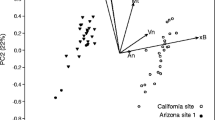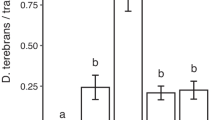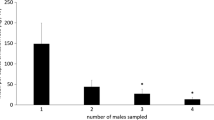Abstract
Each of the pheromone components of the Western pine beetle,Dendroctonus brevicomis LeC. (Coleoptera: Scolytidae), exo-brevicomin (E) and frontalin (F), were released in the forest at various ratios 0.01∶1, 0.1∶1, or 1∶1 to a constant dose of the opposite component (E or F) plus the host monoterpene myrcene (M), which were each released at 1.5 mg/day. The components were released by a new method that combines the principles of chemical diffusion through a tube with mole percentage dilution of the chemical. Both sexes ofD. brevicomis were attracted similarly at comparable ratios (and release rates) of E or F and showed similar logarithmic relationships (r 2=0.92∓0.99). The bark beetle predator,Temnochila chlorodia (Mannerheim) (Coleoptera: Trogositidae) was apparently less sensitive to E thanD. brevicomis, being relatively less attracted to amounts of E equivalent to that released by 70 females, while none were attracted to that from seven females (while this rate still attracted significant numbers of conspecifics). The apparent insensitivity of bark beetles to extreme ratios between pheromone components in contrast to moths is discussed. The advantages of the diffusion-dilution method of releasing semiochemicals compared to previous methods of absorbents, wicks, capillary tubes, and semipermeable plastic membranes are also discussed.
Similar content being viewed by others
References
Bedard, W.D., andBrowne, L.E. 1969. A delivery-trapping system for evaluating insect chemical attractants in nature.J. Econ. Entomol. 62:1202–1203.
Bedard, W.D., Tilden, P.E., Wood, D.L., Silverstein, R.M., Brownlee, R.G., andRodin, J.O. 1969. Western pine beetle: Field response to its sex pheromone and a synergistic host terpene, myrcene.Science 164:1284–1285.
Bedard, W.D., Wood, D.L., Tilden, P.E., Lindahl, K.Q., Jr., Silverstein, R.M., andRodin, J.O. 1980. Field response of the Western pine beetle and one of its predators to host- and beetle-produced compounds.J. Chem. Ecol. 6:625–641.
Birgersson, G., Schlyter, F., Löfqvist, J., andBergström, G. 1984. Quantitative variation of pheromone components in the spruce bark beetleIps typographus from different attack phases.J, Chem. Ecol. 10:1029–1055.
Bjostad, L.B., andRoelofs, W.L. 1981. Sex pheromone biosynthesis from radiolabeled fatty acids in the redbanded leafroller moth.J. Biol. Chem. 256:7936–7940.
Brooks, T.W. 1980. Controlled vapor release from hollow fibers: Theory and applications with insect pheromones, pp. 165–193,in A.F. Kydonieus (ed.). Controlled Release Technologies: Methods, Theory, and Applications, Vol II. CRC Press, Boca Raton, Florida.
Browne, L.E. 1978. A trapping system for the Western pine beetle using attractive pheromones.J. Chem. Ecol. 4:261–275.
Browne, L.E., Wood, D.L., Bedard, W.D., Silverstein, R.M., andWest, J.R. 1979. Quantitative estimates of the Western pine beetle attractive pheromone components, exo-brevicomin, frontalin, and myrcene in nature.J. Chem. Ecol. 5:397–414.
Byers, J.A. 1982. Male-specific conversion of the host plant compound, myrcene, to the pheromone, (+)-ipsdienol, in the bark beetle,Dendroctonus brevicomis.J. Chem. Ecol. 8:363–371.
Byers, J.A. 1983a. Influence of sex, maturity and host substances on pheromones in the guts of the bark beetles,Ips paraconfusus andDendroctonus brevicomis.J. Insect Physiol. 29:5–13.
Byers, J.A. 1983b. Sex-specific responses to aggregation pheromone: Regulation of colonization density by the bark beetleIps paraconfusus.J. Chem. Ecol. 9:129–142.
Byers, J.A. 1987. Interactions of pheromone component odor plumes of Western pine beetle.J. Chem. Ecol. 13:2143–2157.
Byers, J.A., andWood, D.L. 1980. Interspecific inhibition of the response of the bark beetles,Dendroctonus brevicomis andIps paraconfasus.J. Chem. Ecol. 6:149–164.
Byers, J.A., andWood, D.L. 1981. Interspecific effects of pheromones on the attraction of the bark beetles,Dendroctonus brevicomis andIps paraconfusus in the laboratory.J. Chem. Ecol. 7:9–18.
Byers, J.A., Wood, D.L., Craig, J., andHendry, L.B. 1984. Attractive and inhibitory pheromones produced in the bark beetle,Dendroctonus brevicomis, during host colonization: Regulation of inter- and intraspecific competition.J. Chem. Ecol. 10:861–877.
Cardé, R.T. 1984. Chemo-orientation in flying insects, pp. 111–124,in W.J. Bell and R.T. Cardé (eds.). Chemical Ecology of Insects. Chapman and Hall, London.
Cardé, R.T., andBaker, T.C. 1984. Sexual communication with pheromones, pp. 355–383,in W.J. Bell and R.T. Cardé (eds.). Chemical Ecology of Insects. Chapman and Hall, London.
Hughes, P.R., andPitman, G.B. 1970. A method of observing and recording the flight behavior of tethered bark beetles in response to chemical messengers.Contrib. Boyce Thompson Inst. 24:329–336.
Klimetzek, D., andFrancke, W. 1980. Relationship between the enantiomeric composition of α-pinene in host trees and the production of verbenols inIps species.Experienta 36:1343–1345.
Klimetzek, D., Köhler, J., Vité, J.P., andKohnle, U. 1986. Dosage response to ethanol mediates host selection by “secondary” bark beetles.Naturwissenschaften 73:270–272.
Kydonieus, A.F. 1980. Fundamental concepts of controlled release, pp. 1–19,in A.F. Kydonieus (ed.). Controlled Release Technologies: Methods, Theory, and Applications. Vol I. CRC Press, Boca Raton, Florida.
Moeck, H.A. 1970. Ethanol as the primary attractant for the ambrosia beetleTrypodendron lineatum (Coleoptera: Scolytidae).Can. Entomol. 102:985–995.
Nordlund, D.A. 1981. A glossary of terms used to describe chemicals that mediate intra- and interspecfic interactions, pp. 495–497,in E.R. Mitchell (ed.). Management of Insect Pests with Semiochemicals. Plenum Press, New York.
Pitman, G.B., andVité, J.P. 1971. Predator-prey response to Western pine beetle attractants.J. Econ. Entomol. 64:402–404.
Roelofs, W.L. 1979. Establishing Efficacy of Sex Attractants and Disruptants for Insect Control. Entomological Society of America, College Park, Maryland. 97 pp.
Roelofs, W.L., andCardé, R.T. 1977. Responses of Lepidoptera to synthetic sex pheromone chemicals and their analogues.Annu. Rev. Entomol. 22:377–405.
Rudinsky, J.A. 1973. Multiple functions of the southern pine beetle pheromone verbenone.Environ. Entomol. 2:511–514.
Rudinsky, J.A., andRyker, L.C. 1980. Multifunctionality of Douglas-fir pheromone 3,2-MCH confirmed with solvent dibutyl phthalate.J. Chem. Ecol. 6:193–201.
Schlyter, F., Birgersson, G., Byers, J.A., Löfqvist, J., andBergström, G. 1987a. Field response of the spruce bark beetle,Ips typographus, to aggregation pheromone candidates.J. Chem. Ecol. 13:701–716.
Schlyter, F., Löfqvist, J., andByers, J.A. 1987b. Behavioural sequence in the attraction of the bark beetleIps typographus to pheromone sources.Physiol. Entomol. 12:185–196.
Schlyter, F., Byers, J.A., andLöfqvist, J. 1987c. Attraction to pheromone sources of different quantity, quality and spacing: Density-regulation mechanisms in the bark beetleIps typographus.J. Chem. Ecol. 13:1503–1523.
Stewart, T.E., Plummer, E.L., McCandless, L.L., West, J.R., andSilverstein, R.M. 1977. Determination of enantiomer composition of several bicyclic ketal insect pheromone components.J. Chem. Ecol. 3:27–43.
Sturgeon, K.B. 1979. Monoterpene variation in ponderosa pine xylem resin related to Western pine beetle predation.Evolution 33:803–814.
Tilden, P.E., andBedard, W.D. 1985. Field response ofDendroctonus brevicomis to exo-brevicomin, frontalin, and myrcene released at two proportions and three levels.J. Chem. Ecol. 11:757–766.
Tilden, P.E., Bedard, W.D., Wood, D.L., Lindahl, K.Q., andRauch, P.A. 1979. Trapping the Western pine beetle at and near a source of synthetic attractive pheromone: Effects of trap size and position.J. Chem. Ecol. 5:519–531.
Tilden, P.E., Bedard, W.D., Lindahl, K.Q., Jr., andWood, D.L. 1983. TrappingDendroctonus brevicomis: Changes in attractant release rate, dispersion of attractant, and silhouette.J. Chem. Ecol. 9:311–321.
Villars, F.M.H., andBenedek, G.B. 1974. Physics with Illustrative Examples from Medicine and Biology, Vol 2. Addison-Wesley, Reading, Massachusetts, pp. 66–92.
Vité, J.P., andPitman, G.B. 1969. Aggregation behavior ofDendroctonus brevicomis in response to synthetic pheromones.J. Insect Physiol. 15:1617–1622.
Vité, J.P., Volz, H.A., Paiva, M.R., andBakke, A. 1986. Semiochemicals in host selection and colonization of pine trees by the pine shoot beetleTomicus piniperda.Naturwissenschaften 73:39–40.
Wood, D.L., Stark, R.W., Silverstein, R.M., andRodin, J.O. 1967. Unique synergistic effects produced by the principle sex attractant compounds ofIps confusus (LeConte) (Coleoptera: Scolytidae).Nature 215:206.
Wood, D.L., Browne, L.E., Bedard, W.D., Tilden, P.E., Silverstein, R.M., andRodin, J.O. 1968. Response ofIps confusus to synthetic sex pheromones in nature.Science 159:1373–1374.
Wood, D.L., Browne, L.E., Ewing, B., Lindahl, K., Bedard, W.D., Tilden, P.E., Mori, K., Pitman, G.B., andHughes, P.R. 1976. Western pine beetle: Specificity among enantiomers of male and female components of an attractant pheromone.Science 192:896–898.
Author information
Authors and Affiliations
Rights and permissions
About this article
Cite this article
Byers, J.A. Novel diffusion-dilution method for release of semiochemicals: Testing pheromone component ratios on western pine beetle. J Chem Ecol 14, 199–212 (1988). https://doi.org/10.1007/BF01022542
Received:
Accepted:
Issue Date:
DOI: https://doi.org/10.1007/BF01022542




